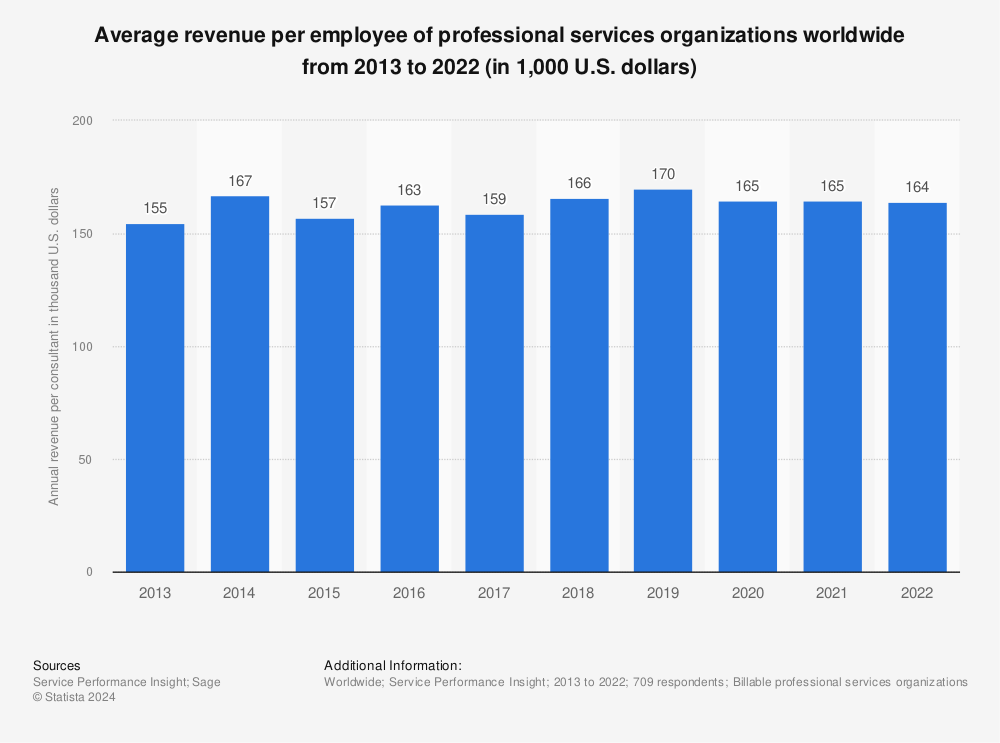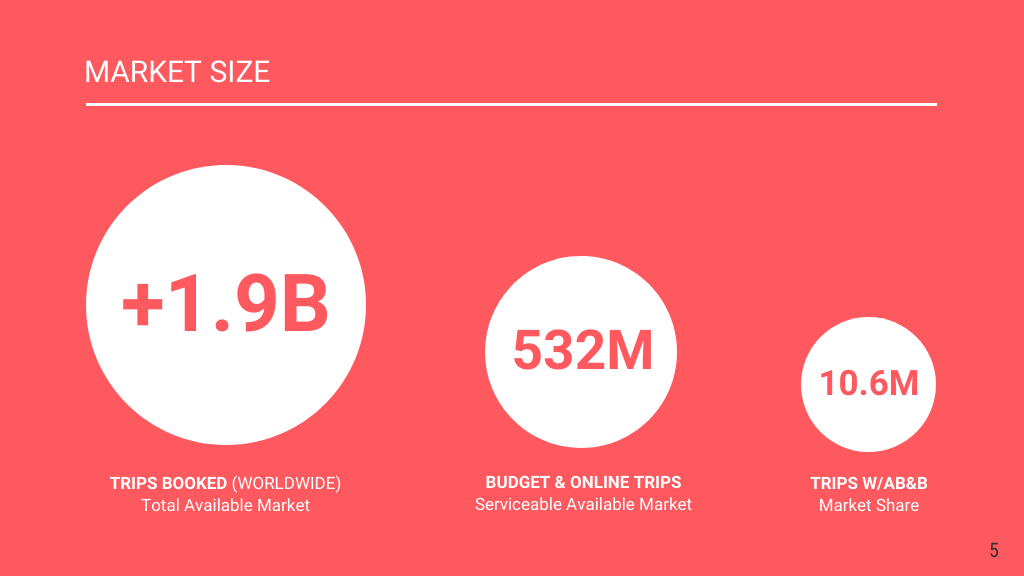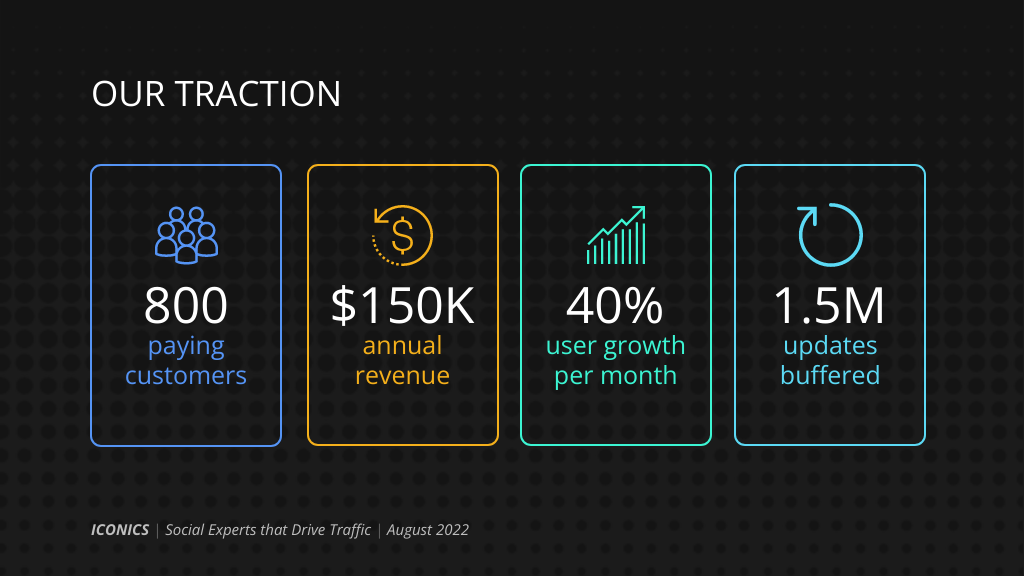When launching a startup, the pitch deck is essential. It serves as the primary tool for communicating with potential investors, outlining the business plan, high-level goals, and financial projections.
A well-crafted pitch deck not only highlights market opportunities but also addresses the financial aspects crucial for securing funding.
Easily share financial data using Venngage’s Presentation Maker and financial pitch deck templates —no design experience needed. Start creating your own pitch deck today.
Click to jump ahead:
- What is a financial pitch deck?
- What are the components of a financial pitch deck?
- What to put in the financial slide of a pitch deck
- Success begins with a great pitch deck
What is a financial pitch deck?
A financial pitch deck is a presentation that provides an overview of a company’s financial performance, projections and investment potential.
It is typically used by startups and businesses to attract potential investors, secure funding or present to stakeholders.
The pitch deck includes key financial metrics and narratives that highlight the company’s growth prospects and financial health.
Not sure what to include in your financial pitch deck? Let’s look at the main components often included in a financial pitch deck next.
What are the components of a financial pitch deck?
What separates a great pitch deck from the standard run-of-the-mill presentation lies in the content. Not just in the written sense, but in visuals.
A business pitch deck is a balancing act that will help companies raise money. But it needs to highlight key metrics that investors expect.
This includes market research, projected growth, and financial projections like MRR/ARR or gross profit, as shared in this pitch deck below.
Most experts agree that a great pitch deck should consist of about 10 slides. Those slides should cover the following topics.
1. The introduction
This is where a business takes the time to answer two questions: who, and why. Who will be your paying customers? Why does your business deserve investment?
2. The problem
Building on the previous point, it’s best to segue into what problem your business is trying to solve. Make sure to justify this slide by presenting real-world situations that investors care about, like in this business pitch example.
3. The team
This is the pitch deck slide where you showcase the people who are going to try to solve the problem you’ve posited.
It’s important that each individual in the team has their own strengths and weaknesses. They should complement each other, while also being experts in their own field, like in this example.
This way, the team can deliver on the gross margin and key milestones promised.
Upload photos of your team members into the Venngage editor. Double-click on the image in the template and a menu will appear. Drag and drop images and easily replace the ones in the pitch deck templates.

Related: 30+ Best Pitch Deck Examples, Tips & Templates
4. The product or service
Take all the previous slides and condense them into one, then answer the question: what solution can my business and my team offer to solve the problem?
It also helps to add a description of how your product will slot into actual practice and tie into the financial models you’ve prepared.
This pitch deck example describes the whole process behind their product. This is a sure-fire way to impress investors.
Related: 20+ Business Pitch Deck Templates to Win New Clients and Investors
5. The target market
At this point, you’ve outlined the basic vision of your business. Now it’s time to talk about who you’re going to sell it to.
The target market is who your business is for. It’s important to know and discuss in detail what kind of people they are, so you’re sure of who you can market to.
Also, make educated guesses around possible monthly churn rate and average customer lifetime. This will show potential investors that you’ve done your research.
This slide from the successful Airbnb pitch deck is dedicated entirely to market sizing. Data like this will give investors the incentive to partner with your company. Insights from a financial marketing agency can also clarify how to position your offering more effectively and align your pitch with the expectations of investment-savvy audiences.
6. The competition
Now that you’re talking about market research, it’s also worth giving some time to competitors within the same field.
Examine who they are, what they’re doing, and most essentially, how you can do all that even better. You can see how this pitch deck colorfully shares its competitive research.
This information needs to go into your pitch decks because it will impact your financial projections.
Related: How to Create a Competitor Analysis Report (Templates Included)
7. The business plan
This pitch deck slide is all about how you plan to execute your vision. Not in a lofty way, but in a tangible real-world way that will bring in a gross profit.
The business model is outlined with a chart in this pitch deck, making it easier to follow and understand.
It helps to have a timeline here of steps your business will take. Include key points about financial information, such as an estimate of when revenues will start pouring in.
Related: 15+ Business Plan Examples to Win Your Next Round of Funding
8. The financials
Some pitch decks live or die by this slide, especially when presenting to potential investors. This is where financial projections are examined.
This is also the pitch deck slide where startups can do some basic accounting information that will help them sum up the following details:
- a balance sheet
- income statement
- a financial model or plan
- possible marketing expenses
- growth trajectory
- gross margin of profit
These slides showcase just how you can share financial information in a pitch deck.
Investors want to know exactly what is expected of them in financial terms before they make a commitment. This is the pitch deck slide that will convince them.
Related: How to Create Engaging, Easy-to-Read Financial Statements with Visuals
9. Contact details
As the heading implies, here’s where you list your contact information in case investors want to reach out to you. It’s good practice to dedicated one particular slide to this.
10. Closing thoughts
Great pitch decks tell stories, so make sure yours has a great and memorable ending.
You can end with a quote, an inspirational speech, or even a heartfelt message about how your business can truly offer value and help those who may need it.
Uber ended their pitch deck with a summary of their successes and next steps.
And all these parts make up the sum of the whole. They all work together to ensure that potential customers, investors, or even partners fully understand what it is your business is trying to create.
What to put in the financial slide of a pitch deck
The financial projections slide is one of the most important in a pitch deck. There are some general rules you can follow if you’re not too sure on what to place emphasis on.
Mention 2-3 key performance indicators (KPIs)
To quantify any underlying assumptions and to back you up when you offer hypothetical projections, it’s a good idea to present your KPIs, like in this minimalist Airbnb pitch deck.
These key metrics and measurements are often used to evaluate performance over time. When setting these up in your pitch deck, it’s recommended that they be quantitative.
This will make it easier to give context and compare data once it’s time to assess.
Include a profit and loss statement
This report in your pitch deck is simple but highly effective. You need to demonstrate traction to convince investors, like in this Iconics pitch deck slide.
To generate this type of income statement, all you need to do is declare your revenue, add your income, and deduct your expenses. All this on a monthly basis.
What remains of your revenue is then declared as your gross profit, if it’s a positive number, or a loss, if it’s a negative one.
Consider your full-time equivalents’ value
A full-time equivalent, or FTE, is a metric that equates to the number of full-time employees and equivalent full-time contractors you have.
Most investors look at a related metric, the Revenue per FTE, in order to see how your business stacks up against your competition. Statista has the current data in comparison.

Find more statistics at Statista
This ratio can be attained by taking the complete revenue for the last year divided by the number of current FTEs.
But keep in mind these elements are applicable even when you’re not raising money or creating a pitch deck.
It’s also a good practice to understand your company’s cash flow. These types of financial models can play a large role in informing your future decisions.
Use a pitch deck template to showcase financial projections
The easiest way to build a financial plan and raise funds is to have a pitch deck template ready to update on a regular basis.
Understandably, not everyone is comfortable delving into the world of finance. It makes sense that some turn to the use of pre-made versions to guide them in this endeavor.
Venngage has financial infographics and pitch deck templates, like this example, that will make the process of startup growth easier.
Visit our library with over 1000 templates for the perfect pitch deck, report, or proposal, and have your financial deck ready in minutes.
Not only are these decks professionally designed, saving you the trouble of having to hire a designer, but they also include pre-formatted slides that already ask for all the information you need to place to make a successful deck.
All the data visualizations are already present, and the accompanying descriptions are laid out. Customize the pitch deck for your company and start attracting new investors.
Related: Creating a Pitch Deck? 5 Ways to Design a Winner
Success begins with a great pitch deck
Most founders know that the majority of startups aren’t profitable. Startup statistics from as recent as 2021 show that up to 90% of most startups fail, with 10% of them folding within the first year.

There are many reasons for this, the most popular of them being misreading market demand, having a poor founding team, or running out of cash.
The last point is extremely relevant, with a whopping 82% of businesses collapsing due to financial issues.
However, while the entrepreneurial ecosystem is cutthroat by nature, that’s not to say that success is improbable. It just means it’s difficult.
And it can all be managed right from the very beginning: by having an efficient, clear, and concise investment pitch deck, like this example from Guy Kawasaki.
You need to communicate your business model, financial models, and estimate the average customer lifetime.
This is the best way for investors to know how much money they’ll need to give your business so you can thrive.
Get your pitch deck design perfect with Venngage’s templates. Make the designs your own by adding your branding via the My Brand Kit feature. Available with Venngage for business.
Use the Autobrand tool to import your logos, fonts, and colors from your website. Then you can easily add your branding across all designs with a single click.

Highlight your financial projections in a successful pitch deck
By following the above tips, you can highlight your business model, income statement, and project annual recurring revenue to investors.
With templates, the difficult part of balancing visual and written communication is taken care of. Now it’s all a matter of customizing the design and inputting your data.
Stand out during your presentation by creating a Venngage pitch deck template. No design experience is required.


















































